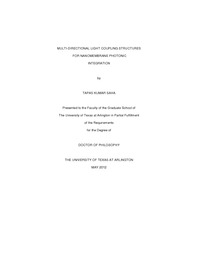
ATTENTION: The works hosted here are being migrated to a new repository that will consolidate resources, improve discoverability, and better show UTA's research impact on the global community. We will update authors as the migration progresses. Please see MavMatrix for more information.
Show simple item record
| dc.contributor.author | Saha, Tapas Kumar | en_US |
| dc.date.accessioned | 2012-07-25T19:09:56Z | |
| dc.date.available | 2012-07-25T19:09:56Z | |
| dc.date.issued | 2012-07-25 | |
| dc.date.submitted | January 2012 | en_US |
| dc.identifier.other | DISS-11679 | en_US |
| dc.identifier.uri | http://hdl.handle.net/10106/11106 | |
| dc.description.abstract | Vertical coupling of light within an in-plane nanophotonic waveguide is an essential step towards the successful future realization of CMOS compatible optical interconnects and photonic integrated circuits. This is especially important, since silicon, though being the material of choice, is an extremely poor emitter of light. Through vertical to in-plane coupling, light can be coupled through any point on the planar on chip and the position is not only confined within the edges of the silicon wafer. Compact wafer scale testing is possible with this approach, without the need for polished edge cleaving. Another important aspect of this research is that nanomembrane technology has opened a new dimension to the 3D vertical heterogeneous integration of different optical materials on Silicon. Since silicon itself is a transparent medium in the telecom band, it cannot become a source or detector of the light. The transferred nanomembrane technology can successfully replace the conventional unreliable bonding process which also wastes too much space within the Silicon wafer. New enhanced integrated on-chip functionalities, new device physics are realizable with the aid of the nanomembrane technology. In Chapter 2 we have presented the design of a compact high efficiency first order grating coupler with Silicon nanomembrane whose performance is extremely robust to fabrication error. Two-dimensional model simulation shows a diffractive power-up efficiency of 81% and a fibre coupling efficiency of 64%. With nanomembrane stacking, it is feasible to integrate the side-distributed Bragg reflector and bottom reflector, which can lead to the diffractive power-up efficiency and the fibre coupling efficiency of 97% and 73.5%, respectively.In Chapter 3 we present, the design of a compact, frequency selective, efficient second-order grating coupler for normally incident light. Traditionally the high efficiency, compact grating couplers are extremely broadband (linewidth>30 nm). Through making use of transverse resonance and evanescent field coupling, the coupler designed, exhibits high frequency-selectiveness with controllable linewidths. Full-wave simulations based on finite-difference-time-domain method demonstrate Q of 2350 with a coupling efficiency of 37%.In Chapter 4 a laser beam angle detector is designed using a second order grating coupler. The designed coupler can detect upto 4° to achieve fast responding on-chip detection of the laser beam steering. The range of the angle that can be determined by this method depends on the linewidth of the coupled resonance, the laser power and the detector sensitivity.In Chapter 5 we have designed a 2D second order grating coupler which can couple surface normal incident light with high coupling efficiency contrast of 7 to 10 between the two orthogonal polarizations over a 24 nm band linewidth. The device can work in illuminated or semi-illuminated environment. The device can give information regarding the direction of the incident source and is extremely promising for fast high contrast thermal imaging.In Chapter 6, we present the main conclusion of our research and the perspectives for future work. | en_US |
| dc.description.sponsorship | Zhou, Weidong | en_US |
| dc.language.iso | en | en_US |
| dc.publisher | Electrical Engineering | en_US |
| dc.title | Multi-directional Light Coupling Structures For Nanomembrane Photonic Integration | en_US |
| dc.type | Ph.D. | en_US |
| dc.contributor.committeeChair | Zhou, Weidong | en_US |
| dc.degree.department | Electrical Engineering | en_US |
| dc.degree.discipline | Electrical Engineering | en_US |
| dc.degree.grantor | University of Texas at Arlington | en_US |
| dc.degree.level | doctoral | en_US |
| dc.degree.name | Ph.D. | en_US |
Files in this item
- Name:
- Saha_uta_2502D_11679.pdf
- Size:
- 13.21Mb
- Format:
- PDF
This item appears in the following Collection(s)
Show simple item record


